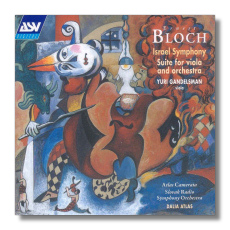
The Internet's Premier Classical Music Source
Related Links
- Bloch Reviews
- Latest Reviews
- More Reviews
-
By Composer
-
Collections
DVD & Blu-ray
Books
Concert Reviews
Articles/Interviews
Software
Audio
Search Amazon
Recommended Links
Site News
 CD Review
CD Review
Ernest Bloch

- Israel Symphony (1916)
- Suite for Viola & Orchestra (1919) *
Adriana Kohutková, soprano
Katarína Kramolišová, soprano
Terezia Bajaková, mezzo-soprano
Denisa Hamarová, alto
Michal Mačuha, baritone
* Yuri Gandelsman, viola
Slovak Radio Orchestra/Dalia Atlas
* Atlas Camerata Orchestra/Dalia Atlas
Academy Sound & Vision CDDCA1148 66:48
Recommendation: If you like Schelomo, you'll like this. My find of the year, especially the suite.
Ernest Bloch (1880-1959, but given inexplicably – and prominently – wrong dates by an editor of this otherwise superb release) came to America from Switzerland, was the teacher of the composers Roger Sessions, George Antheil, Randall Thompson, Quincy Porter, Halsey Stevens and Leon Kirchner, among others, and shares the regrettable present neglect and relative obscurity of these composers. This recording presents two of Bloch's major works, the symphony from his Jewish Cycle (which included Schelomo) and the viola suite, originally for viola and piano, and which dates from around the end of the First World War.
The Israel Symphony (with a name suggested to Bloch by Romain Rolland – Bloch was going to call it Fêtes Juives) is an evocation of ancient Israel and originally was intended to be the first of a huge three part work but Bloch abandoned that idea at the end of the war. It includes some use of traditional chants and horn calls and, according to the notes, some Swiss folk songs. The première was in Carnegie Hall. It is in three movements, beginning with a short, slow and solemn movement which Bloch meant to be meditative, and ending with a largely vocal movement. The long middle movement, marked allegro agitato, and associated by Bloch with Yom Kippur, has an intense and clamorous opening but the mood alternated between that and pensive intervals. The recording annotator, Alexander Knapp, calls it "bold and sometimes barbaric," At one point there is a seeming triple rhythm, no doubt not written that way but with the melody coming between rapid fire trumpets and slower drumbeats. The movement ends quietly but proceeds to the final movement without pause, marked by a harp interlude, with quiet muted trumpet playing before and after that. After about four minutes of purely instrumental music, the five soloists begin to enter, with a text by Bloch. About this section, Knapp says that a "contemplative, pastoral atmosphere combines religious and sensual elements."
I prefer the Suite for Viola and Orchestra to the Israel Symphony, and I even prefer Bloch's Viola Suite to his Violin Concerto. The orchestration is highly effective. The work is in four movements, the first and last of which are two or three times the length of the middle ones. The opening is pungent and attention getting. There is some lively melody, an intense climax, and a quiet ending to the movement, which is marked Lento. This is followed by a scherzo marked Allegro ironico. I hear it as pleasingly grotesque, actually, and it is dancelike in part. The third movement, Lento again, could be called night music. The final movement, Molto vivo, reveals the interest Bloch developed in Far eastern music. Imagine the lively opening as a kind of Chinese Pétrouchka. Then the pace broadens out to give the soloist more prominence. The ending is fairly conventional. If I were a violist I would definitely want this to be in the regular repertoire. I would like that anyway.
Copyright © 2005, R. James Tobin




















